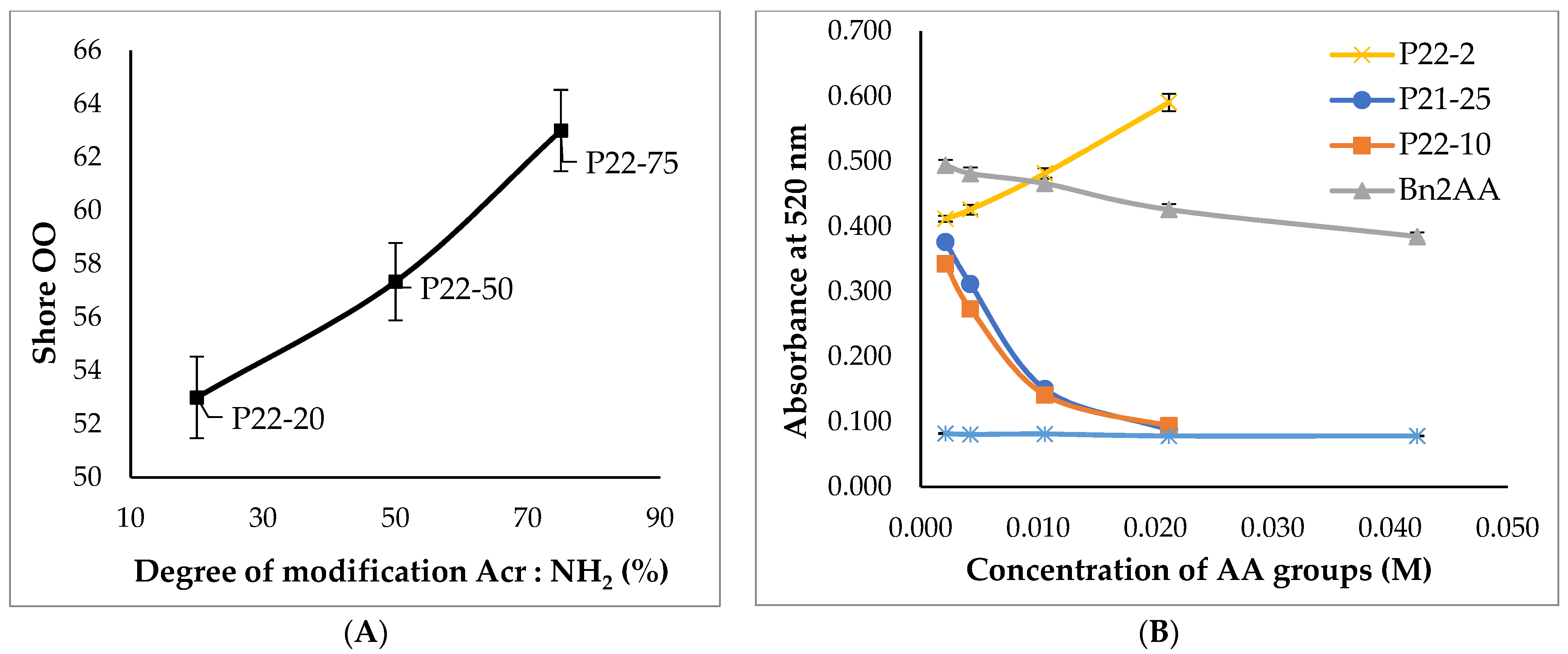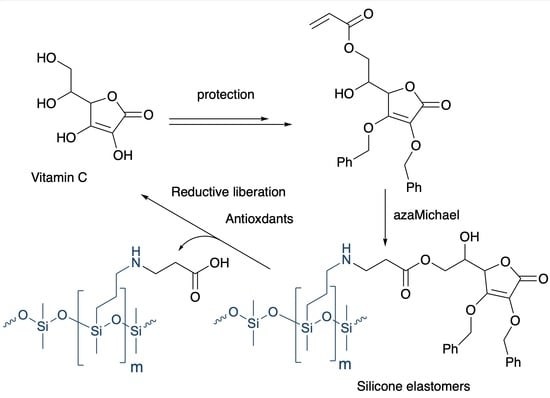Ascorbic Acid-Modified Silicones: Crosslinking and Antioxidant Delivery
Abstract
:1. Introduction
2. Materials and Methods
2.1. Materials
2.2. Methods
2.3. Synthesis of Benzyl-Protected Ascorbic Acid and Modification with Acrylate 1
2.4. Reactions with Benzylated Acryl Ascorbic Acid 1 by Butylamine (Bn2AA)
2.5. Benzylated, Acryl Ascorbic Acid-Modified Silicones
2.5.1. Telechelic Silicone
2.5.2. Pendant Silicones
2.6. Debenzylation (Hydrogenation) of Benzylated Ascorbic Acid Silicones
2.7. Kinetic Study of Benzyl Acryl Ascorbic Acid and Pendant Silicone
2.8. DPPH Assay for Elastomer Samples
2.9. DPPH Assay of Ascorbic Acid and Benzylated Ascorbic Acid Control
3. Results
3.1. Synthesis of Benzyl-Protected Ascorbic Acid and Modification with Acrylate
3.2. Benzylated, Acryl Ascorbic Acid-Modified Silicones and Cleavage of Acylated, Benzylated Ascorbic Acid by Butyl Amine
3.3. Antioxidant Activity
4. Discussion
5. Conclusions
Supplementary Materials
Author Contributions
Funding
Institutional Review Board Statement
Informed Consent Statement
Data Availability Statement
Acknowledgments
Conflicts of Interest
References
- Mangir, N.; Bullock, A.J.; Roman, S.; Osman, N.; Chapple, C.; MacNeil, S. Production of Ascorbic Acid Releasing Biomaterials for Pelvic Floor Repair. Acta Biomater. 2016, 29, 188–197. [Google Scholar] [CrossRef] [PubMed] [Green Version]
- Nagarajan, S.; Nagarajan, R.; Kumar, J.; Salemme, A.; Togna, A.R.; Saso, L.; Bruno, F. Antioxidant Activity of Synthetic Polymers of Phenolic Compounds. Polymers 2020, 12, 1646. [Google Scholar] [CrossRef] [PubMed]
- Rasheed, A.; Azeez, R.F.A.; Rasheed, A.; Azeez, R.F.A. A Review on Natural Antioxidants; IntechOpen: London, UK, 2019; ISBN 978-1-78985-377-3. [Google Scholar]
- Pospíšil, J. Mechanistic Action of Phenolic Antioxidants in Polymers-A Review. Polym. Degrad. Stab. 1988, 20, 181–202. [Google Scholar] [CrossRef]
- Estevinho, B.N.; Carlan, I.; Blaga, A.; Rocha, F. Soluble Vitamins (Vitamin B12 and Vitamin C) Microencapsulated with Different Biopolymers by a Spray Drying Process. Powder Technol. 2016, 289, 71–78. [Google Scholar] [CrossRef] [Green Version]
- Paradiso, P.; Serro, A.P.; Saramago, B.; Colaço, R.; Chauhan, A. Controlled Release of Antibiotics from Vitamin E-Loaded Silicone-Hydrogel Contact Lenses. J. Pharm. Sci. 2016, 105, 1164–1172. [Google Scholar] [CrossRef]
- Al-Malika, S. Reactive Modifiers for Polymers, 1st ed.; Blackie Academic & Professional: London, UK, 1997. [Google Scholar]
- Grassie, N. Developments in Polymer Degradation—7; Springer Science & Business Media: New York, NY, USA, 2012; ISBN 978-94-009-3425-2. [Google Scholar]
- Huang, S.; Kong, X.; Xiong, Y.; Zhang, X.; Chen, H.; Jiang, W.; Niu, Y.; Xu, W.; Ren, C. An Overview of Dynamic Covalent Bonds in Polymer Material and Their Applications. Eur. Polym. J. 2020, 141, 110094. [Google Scholar] [CrossRef]
- Parada, C.M.; Parker, G.L.; Storey, R.F. Polyisobutylene Containing Covalently Bound Antioxidant Moieties. J. Polym. Sci. Part A Polym. Chem. 2019, 57, 1836–1846. [Google Scholar] [CrossRef]
- Spizzirri, U.G.; Iemma, F.; Puoci, F.; Cirillo, G.; Curcio, M.; Parisi, O.I.; Picci, N. Synthesis of Antioxidant Polymers by Grafting of Gallic Acid and Catechin on Gelatin. Biomacromolecules 2009, 10, 1923–1930. [Google Scholar] [CrossRef]
- Buchmüller, Y.; Wokaun, A.; Gubler, L. Polymer-Bound Antioxidants in Grafted Membranes for Fuel Cells. J. Mater. Chem. A 2014, 2, 5870–5882. [Google Scholar] [CrossRef]
- Buchmüller, Y.; Zhang, Z.; Wokaun, A.; Gubler, L. Antioxidants in Non-Perfluorinated Fuel Cell Membranes: Prospects and Limitations. RSC Adv. 2014, 4, 51911–51915. [Google Scholar] [CrossRef]
- Zhang, W.; Li, J.X.; Tang, R.C.; Zhai, A.D. Hydrophilic and Antibacterial Surface Functionalization of Polyamide Fabric by Coating with Polylysine Biomolecule. Prog. Org. Coat. 2020, 142, 105571. [Google Scholar] [CrossRef]
- Wang, H.; Zhu, D.; Paul, A.; Cai, L.; Enejder, A.; Yang, F.; Heilshorn, S.C. Covalently Adaptable Elastin-Like Protein–Hyaluronic Acid (ELP–HA) Hybrid Hydrogels with Secondary Thermoresponsive Crosslinking for Injectable Stem Cell Delivery. Adv. Funct. Mater. 2017, 27, 1605609. [Google Scholar] [CrossRef] [PubMed]
- Brook, M.A. Silicon in Organic, Organometallic, and Polymer Chemistry; Wiley: Hoboken, NJ, USA, 1999. [Google Scholar]
- Kaliyathan, A.V.; Mathew, A.; Rane, A.V.; Kanny, K.; Thomas, S. Natural Rubber and Silicone Rubber-Based Biomaterials; Elsevier: Amsterdam, The Netherlands, 2018; ISBN 9780081021958. [Google Scholar]
- Ibrahim, M.; Bond, J.; Medina, M.A.; Chen, L.; Quiles, C.; Kokosis, G.; Bashirov, L.; Klitzman, B.; Levinson, H. Characterization of the Foreign Body Response to Common Surgical Biomaterials in a Murine Model. Eur. J. Plast. Surg. 2017, 40, 383–392. [Google Scholar] [CrossRef] [PubMed]
- Leivo, J.; Virjula, S.; Vanhatupa, S.; Kartasalo, K.; Kreutzer, J.; Miettinen, S.; Kallio, P. A Durable and Biocompatible Ascorbic Acid-Based Covalent Coating Method of Polydimethylsiloxane for Dynamic Cell Culture. J. R. Soc. Interface 2017, 14, 20170318. [Google Scholar] [CrossRef] [PubMed] [Green Version]
- Marik, P.E.; Khangoora, V.; Rivera, R.; Hooper, M.H.; Catravas, J. Hydrocortisone, Vitamin C, and Thiamine for the Treatment of Severe Sepsis and Septic Shock: A Retrospective Before-After Study. Chest 2017, 151, 1229–1238. [Google Scholar] [CrossRef]
- Suraeva, O.; Champanhac, C.; Mailänder, V.; Wurm, F.R.; Weiss, H.; Berger, R.; Mezger, M.; Landfester, K.; Lieberwirth, I. Vitamin C Loaded Polyethylene: Synthesis and Properties of Precise Polyethylene with Vitamin C Defects via Acyclic Diene Metathesis Polycondensation. Macromolecules 2020, 53, 2932–2941. [Google Scholar] [CrossRef] [Green Version]
- Sivakanthan, S.; Rajendran, S.; Gamage, A.; Madhujith, T.; Mani, S. Antioxidant and Antimicrobial Applications of Biopolymers: A Review. Food Res. Int. 2020, 136, 109327. [Google Scholar] [CrossRef]
- Meththananda, I.M.; Parker, S.; Patel, M.P.; Braden, M. The Relationship between Shore Hardness of Elastomeric Dental Materials and Young’s Modulus. Dent. Mater. 2009, 25, 956–959. [Google Scholar] [CrossRef]
- Bui, R.; Brook, M.A. Catalyst Free Silicone Sealants That Cure Underwater. Adv. Funct. Mater. 2020, 30, 2000737. [Google Scholar] [CrossRef] [Green Version]
- Lü, J.-M.; Lin, P.H.; Yao, Q.; Chen, C. Chemical and Molecular Mechanisms of Antioxidants: Experimental Approaches and Model Systems. J. Cell Mol. Med. 2010, 14, 840–860. [Google Scholar] [CrossRef]
- Ogliani, E.; Skov, A.L.; Brook, M.A. Purple to Yellow Silicone Elastomers: Design of a Versatile Sensor for Screening Antioxidant Activity. Adv. Mater. Technol. 2019, 4, 1900569. [Google Scholar] [CrossRef]
- Wu, X.-Y.; Li, X.-C.; Mi, J.; You, J.; Hai, L. Design, Synthesis and Preliminary Biological Evaluation of Brain Targeting l-Ascorbic Acid Prodrugs of Ibuprofen. Chin. Chem. Lett. 2013, 24, 117–119. [Google Scholar] [CrossRef]
- Jacques, C.; Genies, C.; Bacqueville, D.; Borotra, N.; Noizet, M.; Tourette, A.; Bessou-Touya, S.; Duplan, H. 776 Optimized Vitamin C Prodrug for Controlled Release and Antioxidant Activity. J. Investig. Dermatol. 2020, 140, S103. [Google Scholar] [CrossRef]
- Tai, A.; Goto, S.; Ishiguro, Y.; Suzuki, K.; Nitoda, T.; Yamamoto, I. Permeation and Metabolism of a Series of Novel Lipophilic Ascorbic Acid Derivatives, 6-O-Acyl-2-O-α-d-Glucopyranosyl-l-Ascorbic Acids with a Branched-Acyl Chain, in a Human Living Skin Equivalent Model. Bioorg. Med. Chem. Lett. 2004, 14, 623–627. [Google Scholar] [CrossRef] [PubMed]
- Shibayama, H.; Hisama, M.; Matsuda, S.; Ohtsuki, M. Permeation and Metabolism of a Novel Ascorbic Acid Derivative, Disodium Isostearyl 2-O-L-Ascorbyl Phosphate, in Human Living Skin Equivalent Models. Skin Pharmacol. Physiol. 2008, 21, 235–243. [Google Scholar] [CrossRef] [PubMed]
- Mohammadi Nafchi, A.; Tabatabaei, R.H.; Pashania, B.; Rajabi, H.Z.; Karim, A.A. Effects of Ascorbic Acid and Sugars on Solubility, Thermal, and Mechanical Properties of Egg White Protein Gels. Int. J. Biol. Macromol. 2013, 62, 397–404. [Google Scholar] [CrossRef] [PubMed]
- Lehmann, R.G.; Varaprath, S.; Annelin, R.B.; Arndt, J.L. Degradation of Silicone Polymer in a Variety of Soils. Environ. Toxicol. Chem. 1995, 14, 1299–1305. [Google Scholar] [CrossRef]
- Lehmann, R.G.; Varaprath, S.; Frye, C.L. Degradation of Silicone Polymers in Soil. Environ. Toxicol. Chem. 1994, 13, 1061–1064. [Google Scholar] [CrossRef]
- Kinne, M.; Poraj-Kobielska, M.; Ralph, S.A.; Ullrich, R.; Hofrichter, M.; Hammel, K.E. Oxidative Cleavage of Diverse Ethers by an Extracellular Fungal Peroxygenase. J. Biol. Chem. 2009, 284, 29343–29349. [Google Scholar] [CrossRef]
- Anastas, P.; Warner, J. Green Chemistry: Theory and Practice; Oxford University Press: Oxford, UK, 2000; ISBN 978-0-19-850698-0. [Google Scholar]




Publisher’s Note: MDPI stays neutral with regard to jurisdictional claims in published maps and institutional affiliations. |
© 2022 by the authors. Licensee MDPI, Basel, Switzerland. This article is an open access article distributed under the terms and conditions of the Creative Commons Attribution (CC BY) license (https://creativecommons.org/licenses/by/4.0/).
Share and Cite
Lu, G.; Yepremyen, A.; Tamim, K.; Chen, Y.; Brook, M.A. Ascorbic Acid-Modified Silicones: Crosslinking and Antioxidant Delivery. Polymers 2022, 14, 5040. https://doi.org/10.3390/polym14225040
Lu G, Yepremyen A, Tamim K, Chen Y, Brook MA. Ascorbic Acid-Modified Silicones: Crosslinking and Antioxidant Delivery. Polymers. 2022; 14(22):5040. https://doi.org/10.3390/polym14225040
Chicago/Turabian StyleLu, Guanhua, Akop Yepremyen, Khaled Tamim, Yang Chen, and Michael A. Brook. 2022. "Ascorbic Acid-Modified Silicones: Crosslinking and Antioxidant Delivery" Polymers 14, no. 22: 5040. https://doi.org/10.3390/polym14225040






